The clown loach (Chromobotia macracanthus), known for its striking appearance and playful behavior, is one of the most admired freshwater fish in the aquarium hobby. Native to the slow-moving rivers and flooded plains of Southeast Asia, this species is loved for its vibrant orange and black stripes, which stand out in any tank.
Unlike many other types of loaches, clown loaches are active during the day, making them a lively addition to your aquarium. Though they are bottom dwellers, these fish are highly social and often engage in playful interactions with each other, adding a dynamic element to their environment. Growing up to 12 inches (30 cm) in captivity, they require spacious tanks with plenty of hiding places.
In this guide, you’ll learn how to care for clown loaches, including their ideal tank conditions, breeding challenges, feeding preferences, and selecting suitable tank mates.
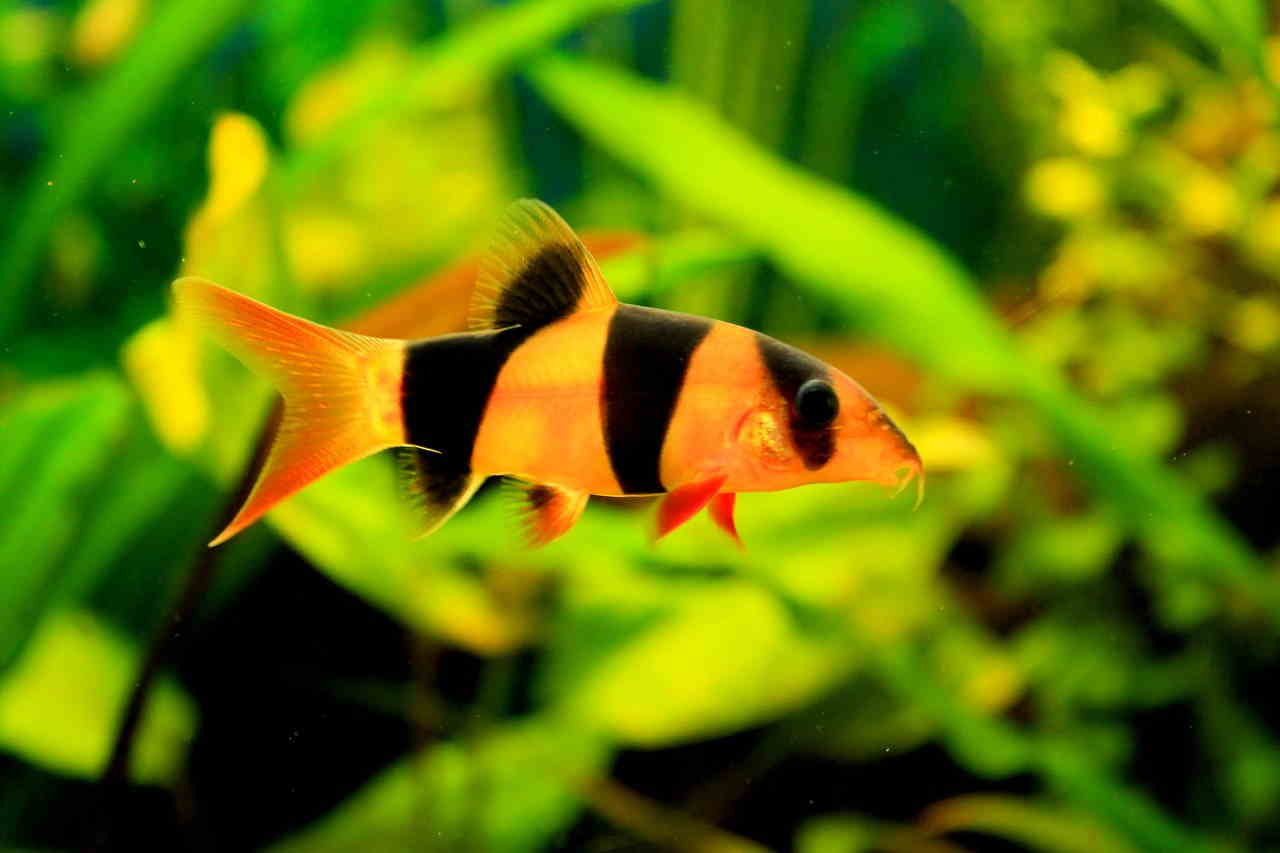
Contents
Habitat in the wild
The clown loach, a member of the botiidae family, was first described in 1852 by Dutch ichthyologist Pieter Bleeker. Initially classified under the loach family, it wasn’t until 2004 that Swiss ichthyologist Maurice Kottelat reclassified it into its own genus, Chromobotia, reflecting new scientific understanding.
Clown loaches are native to Southeast Asia, particularly Malaysia, Borneo, Sumatra, and Kalimantan. They thrive in river tributaries but migrate to smaller streams and floodplains during the rainy season to spawn. These seasonal migrations are triggered by rising water levels, with fish moving upstream to breed in flooded meadows and boggy areas. Water conditions in these rivers can vary greatly, with temperatures, pH, and water clarity changing based on the season. Generally, these rivers are soft and tea-colored, flowing through dense rainforests, which create shadowy environments ideal for the clown loach.
The clown loach’s natural habitat consists of forested, boggy streams with slow-moving water, thick vegetation, and a substrate covered in fallen leaves, branches, and roots. During the rainy season, the faster-flowing main tributaries become turbulent, making it difficult for plants to grow. These conditions drive the loaches into calmer, more vegetated areas to spawn.
Interestingly, in parts of its native range, the clown loach is used as a food source. However, due to international demand, many are caught from the wild and sold in the aquarium trade. Sumatra’s city of Palembang, located along the River Musi, serves as the primary hub for loach exports, though the fish also face ecological threats. Unregulated capture, pollution, and habitat destruction are rapidly reducing their numbers, raising concerns about their long-term survival.
Another key region for clown loach fishing is Pontianak, a city in West Kalimantan situated on the River Kapuas. Here, ecological issues arise due to timber rafting, which disrupts the fish’s habitat.
There are slight variations between the clown loach populations from different regions. For example, loaches from Borneo often have black-colored pelvic fins, while those from Sumatra display red-colored fins. These regional differences suggest that further study could reveal the existence of distinct subspecies.
Due to the inaccessibility of their habitats, scientists have long struggled to gather reliable data on clown loaches’ wild behavior, life cycle, and breeding habits. What is known is that they spawn during the rainy season, typically from December to February. Migration starts in September or October, depending on local climate conditions. The fish travel upstream to boggy, reed-filled tributaries, where they lay eggs that drift downstream and become lodged in vegetation. After hatching, the fry feed on microorganisms in these floodplains and remain there until they grow to about 30 mm in length by around two months old.
In Indonesia, regulations now prohibit the capture of large clown loaches, though smaller specimens are still caught using traditional methods. One popular method involves bamboo sticks with hollow segments placed along riverbanks. At night, the fish swim into the holes, and in the morning, the fishermen return to collect their catch. These methods have been used for years, particularly during the peak season in February, when the fish measure between 20 and 80 mm.
A more modern technique is employed on the River Batang Hari in Sumatra, where local communities gather larvae from flooded areas, rear them, and sell them to exporters. This process produces around 10 million clown loaches annually.
There is some evidence that the population in the Danau Sentarum lake system on Borneo does not follow the typical migration patterns observed in other regions, though this remains unconfirmed. The best time to purchase a clown loach is between April and May, when the fish are healthier, having not been subjected to poor conditions in small containers for long periods.

Description
Size
Clown loaches can grow to impressive sizes, making them one of the larger species of loaches. While many sources list their maximum size at around 30 cm (11.8 in), individuals in the wild have been known to reach up to 40 cm (15.8 in). In aquariums, however, their size tends to be more modest, usually ranging between 15–20 cm (5.9–7.9 in). The growth rate and final size of clown loaches are heavily influenced by factors such as the size of the tank, the quality of their diet, and water conditions. For example, providing a spacious environment with high water quality and a balanced, varied diet can encourage healthier growth and allow the fish to reach their potential size in captivity.
Growth rate
Most clown loaches available in the aquarium trade are wild-caught, coming from forested streams and rivers in Southeast Asia. In tanks, these fish grow slowly, and it’s rare for them to reach their full wild size. However, with the right conditions—such as a spacious tank, high water quality, and a nutritious diet—they can grow up to 10–15 cm within their first year. Despite this, they seldom reach the larger sizes seen in the wild, where growth is typically faster due to more natural environmental factors.
Lifespan
Clown loaches are known for their remarkably long lifespan compared to many other freshwater fish species. In a well-maintained aquarium, they can live for 15 to 20 years or even longer. When purchasing juveniles, it’s important to remember that this longevity is only achievable with proper care. This includes providing a large enough tank, maintaining excellent water quality, and offering a diverse and nutritious diet. With these optimal conditions, clown loaches can thrive and live out their full potential lifespan.
Nocturnal
As a rule, loaches are nocturnal creatures, so it is almost unnoticeable during the daytime. However, this isn’t about clown loach. It is very active during the day, but it’s a bit timid. It enjoys the company of fishes of the same kind. However, it can be kept in a tank and with other types of fishes.
Body
The clown loach has thin, delicate scales that are almost embedded in its skin, though they are not scaleless. This makes the fish more vulnerable to toxins in the water, as its skin provides less protection compared to other species. For this reason, it’s crucial to ensure the tank water is clean and free of pollutants, and it’s best to avoid using medications designed for fish with traditional scales.
One distinctive feature of the clown loach is the pair of protective spines located in skin folds under its eyes. These spines, which help the fish defend itself in the wild, are rarely visible in an aquarium unless the fish is stressed. They emerge when the loach feels threatened, for example, during handling or when being removed from the tank. Care should be taken during this process, as the spines can get caught in the net, and in larger specimens, they can even cause injury.
Clown loaches have elongated, rounded bodies that are brightly colored, with hues ranging from yellow to orange-red. They are marked by three vertical black stripes, and their dorsal fins are mostly black, with the lower portions shaded yellow. Juveniles exhibit the most vivid coloration, which gradually fades as they mature, though they remain visually striking. Their pelvic fins and tail are a vibrant mix of red and black. In the wild, this bold coloring allows them to blend into the vegetation.
The loach’s mouth is adapted for bottom-feeding, allowing it to sift through substrate in search of food. It also has four pairs of barbels, whisker-like appendages that help it detect food in the murky waters of its native rivers.
When clown loaches feel threatened, such as when being removed from the tank, they may release their protective spines and emit a chattering sound. Interestingly, some loaches also make this noise in the evening, even when they aren’t in danger. The spines only appear briefly, for about half a second, making it difficult to observe this behavior closely.
| Characteristic | Description |
|---|---|
| Scientific Name | Chromobotia macracanthus |
| Common Name | Clown Loach, tiger botia |
| Size | Up to 12 inches (30 cm) in length |
| Coloration | Orange to reddish-brown body with black vertical stripes |
| Lifespan | Up to 15-20 years in captivity |
| Native Habitat | Freshwater river systems in Southeast Asia |
| Social Behavior | Social and best kept in groups of 5 or more |
| Activity Level | Playful and active |
| Tank Size | Minimum of 75 gallons (284 liters) |
| Water Temperature | 75-86°F (24-30°C) |
| Water pH | Slightly acidic to neutral (6.0-7.5) |
| Diet | Omnivorous; feeds on small invertebrates, insects, worms, and plant matter |
| Compatibility | Generally peaceful but may be aggressive towards smaller or similar-shaped tankmates |
| Breeding Difficulty | Challenging; successful breeding is uncommon in home aquariums |
| Special Considerations | Sensitive to water quality; regular water changes and monitoring are necessary |
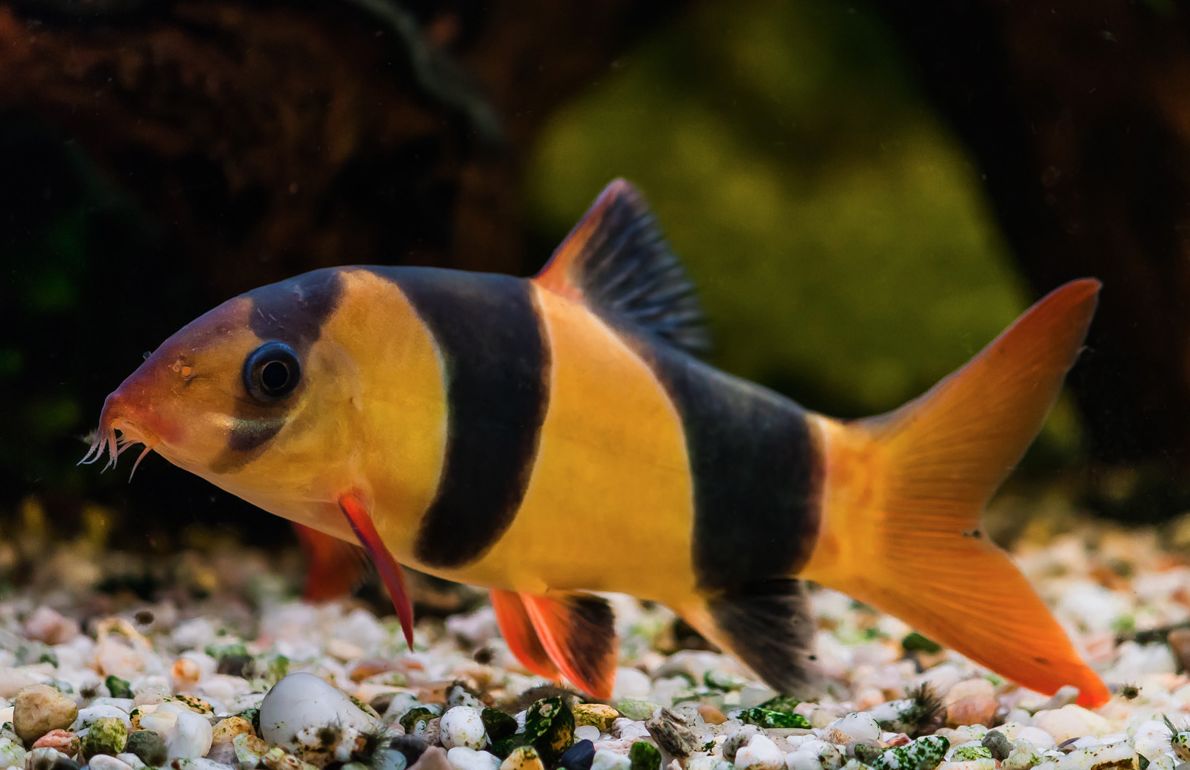
Difficulties in keeping
It is a fish of average difficulty to keep. This is a schooling species that form a complex social hierarchy. Thus they should be kept in a group of at least 5-6 species, while it’s better to be 10 and more. At that, they grow to be quite large so that they won’t survive in small tanks. However, clown loach, unlike other loach species, is active not only in the evening but also during the day. They are very spry, and it is difficult to take your eyes from them swimming in the tank.
Care and keeping in a tank
It is a completely peaceful fish, and it spends most of the time in the bottom part of the tank. Clown loach juveniles, as a rule, are very funny and active. When growing up, they become lazier and like lying in covers. The most spread fear of beginners aquarists is that they start to panic when the fish disappears for several days. Quite often, it happens with newly bought fishes.
Those who have had these fishes already know that sometimes they can lay on a side (even sleeping on the side) and scare the beginners. But after the fish had its rest, it continues swimming. Often clown loach lays on a side when pH is low because the water in a tank wasn’t timely renewed. However, it never was a problem. After lying for some time, the fish gets back to its normal state itself.
Tank size
Clown loaches are highly active, social fish that thrive in schools. When determining how many loaches to keep, it’s essential to consider the size of your tank. For a group of 3-5 loaches, a minimum tank size of 100 gallons (454 liters) is recommended. The larger the school and the tank, the more comfortable the fish will be. In larger groups, they tend to grow faster, exhibit less stress, and show almost no signs of intragroup aggression.
Although you can start juveniles in smaller tanks, it’s important to perform partial water changes daily to maintain water quality. Additionally, the tank should have a height of at least 60 cm (23.6 inches) to ensure the loaches feel secure. In smaller tanks or with lower water levels, clown loaches may experience stress, which can affect their overall health and behavior.
Water parameters
Clown loaches thrive in well-aerated, filtered water with a strong flow, simulating their natural river habitat. It’s important to renew about 30% of the tank’s water weekly to maintain clean conditions. They prefer soft water with a hardness between 5-12 dGH and a pH range of 6.0-7.5, though they can tolerate slightly harder water (up to 25 dGH) if they have adapted to local conditions. The ideal temperature range for clown loaches is between 75-86°F (24-30°C), reflecting the warm, tropical climates of their native rivers in Southeast Asia.
One important consideration is that clown loaches are highly sensitive to salt. Due to their almost scaleless bodies, salt can significantly irritate their skin, so it’s best to avoid using salt in their tank altogether.
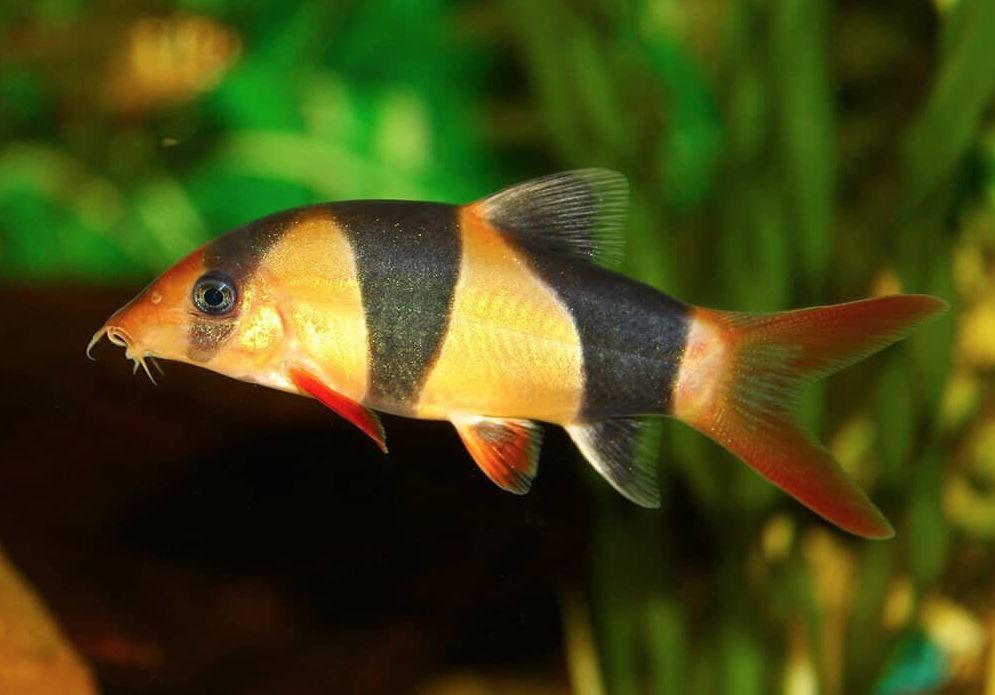
Tank setup: decorations and plants
Clown loaches require plenty of shelters to feel secure, as they naturally like to hide and explore their surroundings. You have flexibility in selecting tank decorations, but a natural setup typically includes a substrate of large-grained sand or small gravel, along with smooth stones, pebbles, driftwood, roots, or branches. Avoid sharp-edged stones, as clown loaches are known to squeeze through small gaps, which can pose a risk of injury. To prevent accidents, any small cracks should be sealed with aquarium-safe silicone.
These loaches are agile swimmers, capable of quick movements, even tail-first, and can navigate through the tightest spaces. They mostly swim near the bottom in search of food but can easily venture into mid-water layers. Given their tendency to jump, it’s important to keep the tank covered.
Lighting should be dim, which mimics their natural habitat and reduces stress. Plants like Microsorum Pteropus and various types of Anubias thrive in low-light conditions and provide additional shade and shelter for the loaches, enhancing the tank’s environment.
Filtration
Clown loaches thrive in well-oxygenated water with a gentle flow. To ensure optimal conditions, it’s best to use a canister filter, which provides efficient filtration and helps maintain high oxygen levels. These fish are sensitive to organic compounds and require exceptionally clean water, so avoid placing them in a newly set-up tank that hasn’t yet established biological balance. To keep the water pristine, perform a weekly water change of 30% of the tank’s total volume.
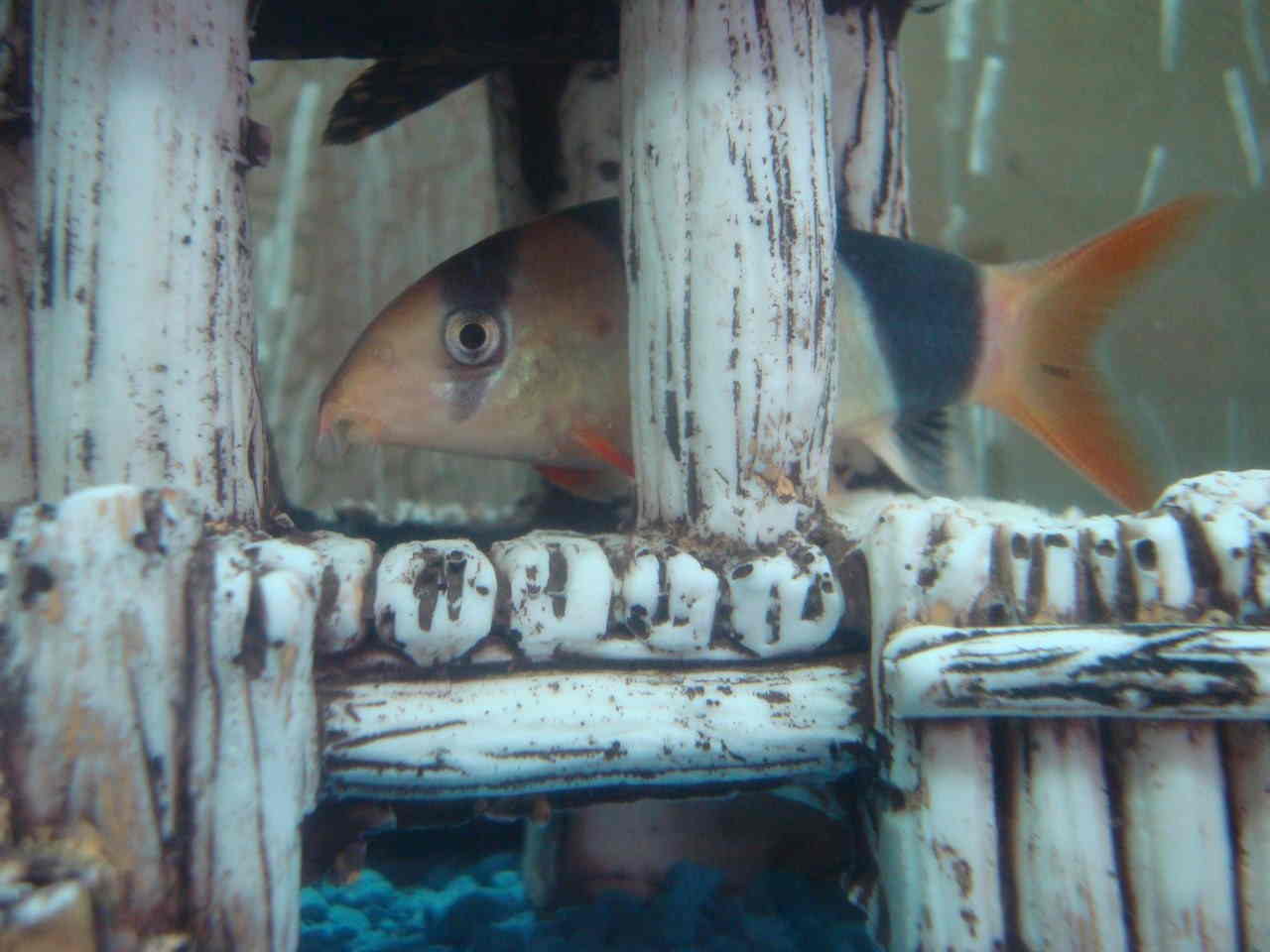
Diet
Clown loaches are not particularly demanding when it comes to food. In the wild, they feed on worms, snails, insect larvae, and other small, spineless creatures, as well as aquatic vegetation. This makes them omnivorous, requiring a diet that includes both protein and plant-based foods. Common foods offered in aquariums include cucumber, melon, and zucchini. However, be aware that these can impact water quality, so it’s often better to use specialized tablet food designed for bottom-dwelling fish.
While clown loaches may nibble on algae in the tank, they are not effective algae controllers like some other species, such as plecos or certain catfish. Their algae consumption alone may not keep algae growth in check.
In an aquarium, clown loaches are easy to feed and accept a variety of foods. They eagerly consume high-quality flakes, granules, and tablets. Live or frozen foods, such as bloodworms, tubifex, and brine shrimp, are also excellent choices.
Although loaches can eat snails, including Malaysian snails, they are not the most reliable solution for controlling snail populations. They will only eat snails when hungry and may prefer other foods at other times. For effective snail control, consider alternative methods as outlined in our article on snail management.
Be mindful that clown loaches may also munch on plants, occasionally damaging species like Echinodorus. Providing adequate plant-based food in their diet, such as special tablets, cucumber, lettuce leaves, spinach, and peeled squash, can help mitigate plant damage. Ideally, plant-based foods should make up to 40% of their total diet.
For the best results, use specially formulated sinking pellets or flakes designed for bottom-dwelling fish. These provide a balanced mix of protein and nutrients, supporting the overall health of your clown loaches.
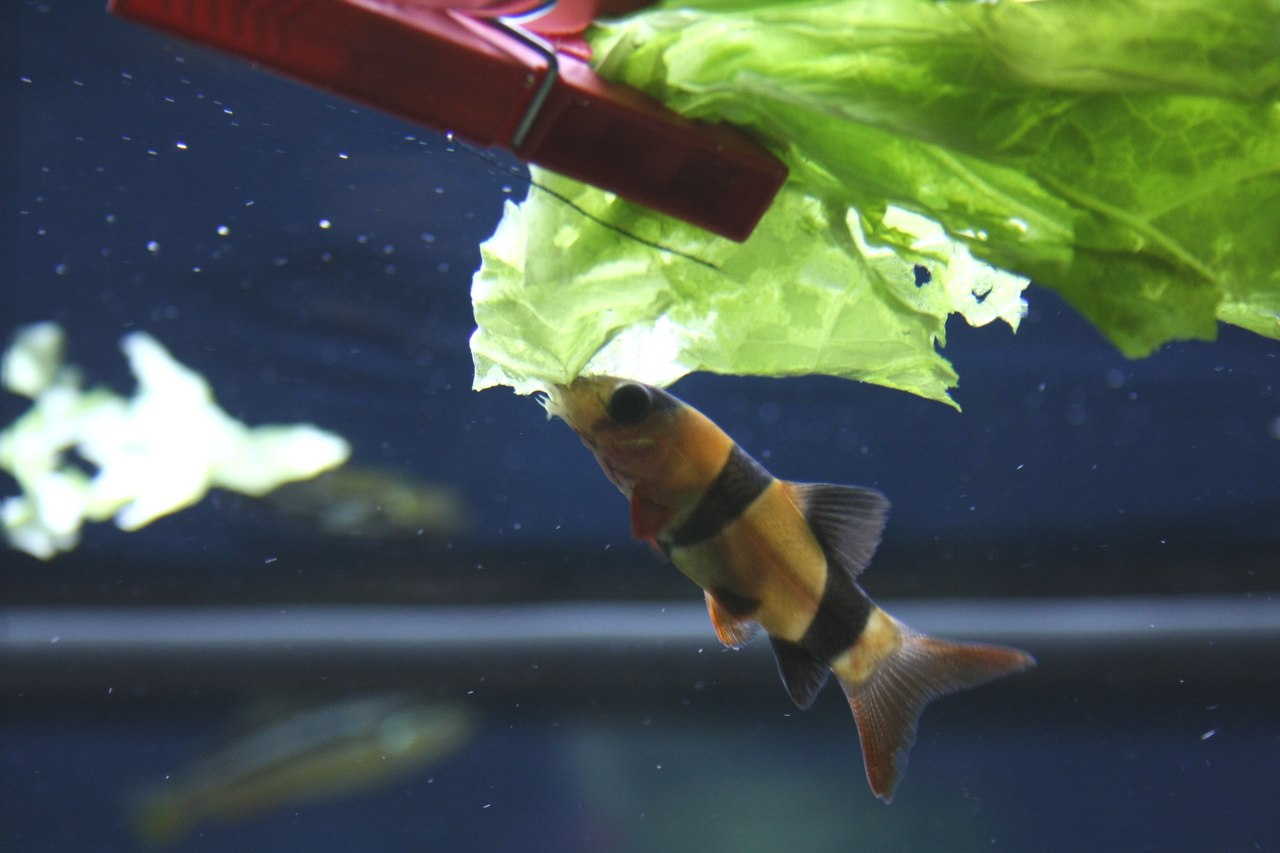
Behavior in the aquarium
Clown loaches are schooling fish, and it’s important to have several fishes of this kind in a tank. The minimal number is 3, but it’s better when there 5 or more species in a tank. In such school, there is a hierarchy, when alpha male scares more weak species off the food.
Provided with ideal tank conditions, the fish will demonstrate all its interesting behavior.
As a result of their fight for dominancy, when you put the clown loach into a new tank, some species may have their color fade. Such a phenomenon may also occur in a stable group since some species sometimes try to get a higher position in the hierarchy. This shouldn’t give cause for the aquarist’s concern.
Currently, there are no scientific studies of clown loaches’ behavior. Within amateur aquaristics, there were some observations made, showing that the species with the highest hierarchy position (alpha-species) influences all other group members’ behavior.
You may often see a young species swimming next to adult species and copying its every movement. At that, there may be several species like this. The reason for such behavior is unknown yet. Possibly, the group has to stay close when the river water level rises during the flood. Maybe this helps them to resist the water flow, and maybe this behavior has a communicative function.
One more interesting feature of clown loach is the ability to make some chattering noise. This way, the fish reacts to danger, and in the wild, it deafens the juveniles by this sound and hunts them. This fact should be considered when choosing tank mates so that it won’t scare small fishes.
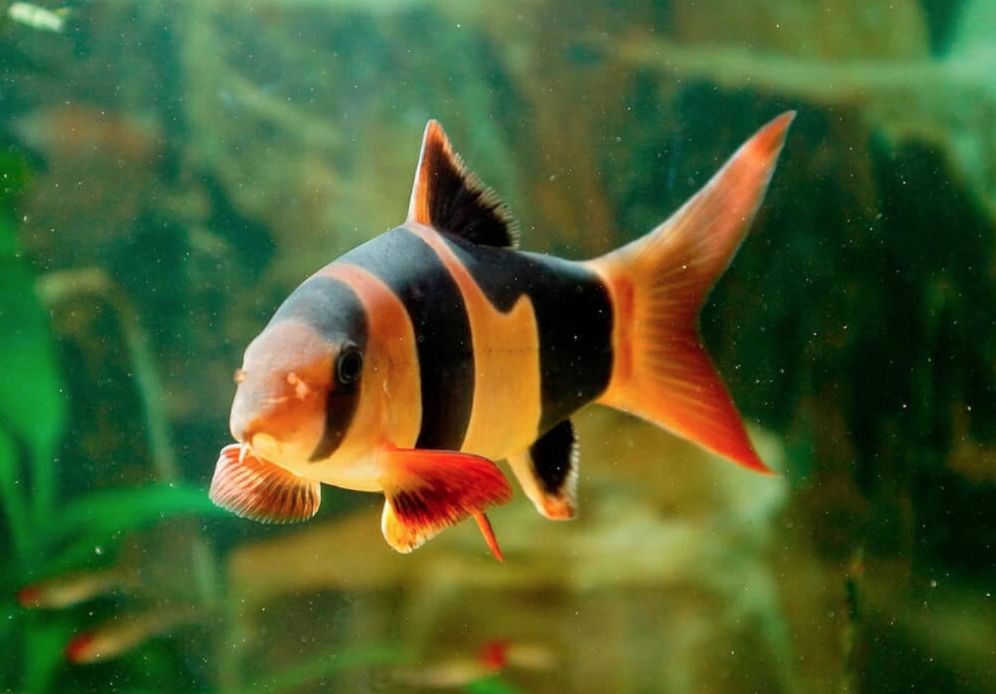
Tank mates
Clown loaches are highly social fish that thrive in groups. It’s recommended to keep them in groups of at least five or more individuals. This group dynamic creates a more natural and comfortable environment, fostering their social behaviors and reducing stress.
When kept in smaller groups or alone, clown loaches can become timid, hide more frequently, and display less of their natural behaviors. In a group, they are able to establish a hierarchy and engage in playful interactions, contributing to their overall well-being.
Proper tank setup is crucial for keeping loaches. Ensure there is ample space, numerous hiding spots, and suitable tankmates to accommodate their social needs. To manage their territory-dependent behavior, it’s important to divide the tank bottom with decorations and provide plenty of shelters. This helps minimize aggression and territorial disputes.
It’s worth noting that clown loaches, especially those that have grown up together, tend to be more tolerant of each other. However, they might not always welcome new tankmates, including other loach species like yoyo loaches. Introducing newcomers slowly and ensuring ample hiding spots can help ease the transition and reduce potential aggression.
Are clown loaches aggressive?
They are generally peaceful and non-aggressive fish, making them a great addition to many community tanks. However, their behavior can vary based on several factors, including tank size, individual temperament, and the presence of other tank mates.
In certain situations, clown loaches may display territorial behavior, especially if they feel crowded or if there are tank mates with similar shapes or sizes. They might become more assertive and chase other fish away from their preferred hiding spots. To help prevent territorial disputes, provide plenty of hiding places and ensure the tank is spacious enough for all inhabitants.
Although clown loaches are usually not aggressive towards other fish, their playful and active nature can sometimes inadvertently stress or intimidate more docile tank mates. It’s important to consider the temperament and compatibility of other fish species when housing them with loaches. Ensuring a well-planned tank setup with ample space and hiding spots can help create a harmonious environment for all the fish.
Compatible fishes
Large clown loaches are one of few fishes that can keep company for African cichlids. Often they are larger than the latter, so cichlids don’t make any attempts to attack them. Nevertheless, it’s important to create many shelters to avoid fights for the territory between the fishes. Also, you should keep in mind that loaches prefer softer water than African cichlids.
Large predator fish kinds from America (like oscar fish or green terror cichlid) sometimes may dwell with clown loaches. Large cichlids are very seldom interested in what happens on the bottom, and loaches can hide quite well. Don’t forget to feed the predators with quality and nutritious food since full-bellied fishes demonstrate more loyalty towards their tank mates than hungry ones. To exclude violent behavior, grown-up loaches are put to a tank with young cichlids. Nevertheless, you should monitor the predators’ behavior.
However, calm angelfishes and discus are one of the best tank mates for clown loaches. They are large enough to fight with the latter if necessary, and they do not dwell close to the tank bottom. They prefer the center area of the tank.
There will be no problem if loaches live together with lively tiger barbs. While the latter will search the bottom for something to eat, barbs play hide-and-seek with their relatives.
You can also keep clown loach with arowana. It dwells near the water surface and isn’t interested in anything behind it. The only thing is that the loach should be large enough so that arowana won’t treat it as food.
Incompatible fishes
Goldfish should be kept in species tanks, especially short-bodied species with modified bodies and long veiled fins. Active loaches may haunt slowly swimming goldfish and try to nip their fins.
Most popular bettas kinds – they have well-developed fins that loaches can easily damage, especially considering some bettas habit to have rest laying on the tank bottom.
Guppies are also not the best idea in terms of loaches tank mates. Firstly, they are too small compared to clown loach; secondly, they have long veiled fins that stop them from swimming fast.
These are territory-dependent fishes that actively protect their spots. Therefore, other bottom-dwelling representatives are not welcome. Thus, dwelling together with cory catfishes (like, panda cory) isn’t always a success, especially if the tank bottom square is small.
Gender differences: male vs female
Distinguishing between male and female clown loaches is quite challenging due to their minimal physical differences. Typically, gender differences become apparent only during reproduction, and even then, identifying males from females can be difficult. The most noticeable sign is that females have a rounded abdomen when they carry eggs, while males generally have more developed pelvic fins.
Clown loaches reach reproductive maturity at around 5 years of age and when their body length is at least 12 cm. However, successful breeding in captivity is rare and challenging, often requiring specific conditions and a well-maintained environment to stimulate spawning.
Breeding
In some references, there is some information about the successful breeding of the clown loach in a tank. However, mainly breeding is performed in the fish farms using some hormone injections.
Earlier, all the fish sold on the markets came from Sumatra, but nowadays, this is different. Together with capturing and selling thousands of wild species, fish hatcheries of South-West Azia have been breeding clown loaches artificially using hormone injections for many years.
It is rather difficult to breed fish in a tank. The number of successful spawnings is very little, which is no surprise, considering the complexity of their natural breeding cycle.
Quite often, failures are considered to be due to using species that aren’t reproductive yet. However, the real reason is different. Wild species, when they migrate for spawning, have an average size from 12 to 20 cm and become reproductive when their size is 12 – 15 cm, while larger species don’t migrate and stay in the rivers mainstream all year round. This testifies that they don’t have any offspring after some specific age.
Despite there are some facts that it is possible to breed clown loaches in a tank.
Over a long period of time, only one such successful breeding attempt was acknowledged. It happened about 30 years ago, in a tank of some amateur aquarist from Montreal, who once, when taking a large burhead bush from the tank, found 39 grown-up clown loaches.
There was a strong filtration system in the tank using peat as a filtering substance, at that pH was about 6.2, water hardness – 2 dGH, and its temperature 28—29°C.
Standard water renews procedures allowed maintaining nitrites concentration less than 0,05 mg/l.
It is unknown how the breeding occurred since the fish were always hiding under the snags and fed only in the evening. They were fed with grated beef heart and pelletized feed with prawns.
Summarizing the experience, we can conclude the following:
- Firstly, a spawning tank must be large enough, especially when breeding large species.
- Secondly, strong and quality water filtration is required.
- Thirdly, for spawning, you should use old tank water with insufficient addition of fresh water (1/5—1/6 of the tank volume), hardness 5—6 dGH, pH 6.8—7.0, temperature 30-32°C.
Strong flow is a must. To create it, you should use specialized devices made for marine aquaristics. You should upgrade the spawning tank a bit (put Plexiglas insertions in its corners to ensure that the water flow won’t lose its energy in dead zones).
There is no sense in using mechanical pumps since the eggs like rainbow shark and Chinese Algae Eater ones constantly float in the water and move with the water flow from one place to another.
You can use flat stones and snags as a spawning substrate and put them on the spot with the strongest flow. The spawning intensity hinges on the water flow strength. There must be 3-4 males for one female in the tank. Hormone injections are done in stages.
Once the spawning is over, the breeders are removed. The water flow generator is turned off, and additional air sprayers are installed. At the water temperature of 29—31 °C in 2—3 hours, you can already see fertilized eggs – they are transparent. The eggs that became white weren’t fertilized, and they must be removed from the tank.
Eggs incubation continues from 18 to 20 hours, depending on the water temperature. Hatched larvae are extremely small and gather in the darkest places of the tank. The juveniles start to swim on the 4th day. At this time, you should feed them with the smallest rotifers kinds, cyclopes nauplii together with green Euglena.
The most critical time of the juveniles’ life is their first month of life. Thus, you must precisely monitor water and food quality during this time. By the end of the month, large juveniles become 13-17 mm long, small ones – 7-10 mm, and they start to obtain their parents’ coloring.